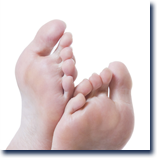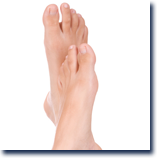 |
 |
 |
 |
 |
Treatments
A choice of treatments are available and some are listed below. If you have specific needs that are not mentioned here, please do not hesitate to telephone or email Beverley to discuss your requirements.
Aging Feet
Older feet tend to have more problems as a result of skin becoming thinner and loosing it’s elasticity, joints showing signs of osteoarthritis (wear and tear) and healing taking longer. Help is available to relieve pain, maintain mobility and promote quality of life. This can involve help with nail care, exercises to tone up muscles and stimulate circulation, padding for painful areas and advice on suitable footwear.
Athletes Foot
Tinea Pedis or more often referred to as Athletes foot, is a common but potentially embarrassing condition, caused by a fungal infection of the skin and nails. It is so called, as athletes and swimmers are particularly prone to picking up this infection in swimming pools, showers and changing facilities. The skin is usually red with cracking, peeling or blistering. It is frequently accompanied with an unpleasant smell and a burning or itching sensation. Nails often become unsightly with discolouration. With good foot hygiene and simple treatments these problems can usually be overcome.
Corns and Callus
These conditions are the body’s reaction to pressure and friction and can appear anywhere on the foot where the skin has been rubbed. Callus (hard skin) is an extended area of thickened skin. When pressure becomes excessive, it usually results in a corn. This can be due to footwear, prominent bones or the way in which we walk. Treatment involves reducing the callus or removing the corn and then addressing the underlying cause.
Diabetic Assessments
Diabetes is a long-term condition in which high blood sugars damage blood vessels and nerves in the feet resulting in poor healing and loss of sensation (neuropathy). This can result in unknowingly damaging your feet. Some people also go on to develop a condition called painful peripheral neuropathy. These conditions cannot be cured but a lot can be done to improve them.
Annual diabetic assessments by a qualified podiatrist are essential to maintaining healthy feet if you have diabetes and will include assessing your vascular supply and sensation, as well as providing an opportunity for you to discuss any concerns you have about your feet. If necessary a care plan can be agreed for helping you to maintain your feet, i.e. regular nail cutting.
Ingrown Toe Nails
This is when a piece of nail pierces the skin and it usually affects the big toe nail. The main causes are trauma and poor nail cutting. It can be a very painful condition with bleeding and pus if an infection is present. Treatment is dependent on the severity of the condition. Some cases only require conservative management by removing the offending nail, advice on nail care and monitoring the nail as it grows. In a minority of cases where there are recurrent infections nail surgery may be required.
Leisure Feet
You don’t have to have an underlying medical condition to have treatment by a podiatrist. One off treatments can be available to remove callus (hard skin) and cut nails before a special occasion or holiday.
Managing Deformity
Many people suffer from changes to their foot shape as they get older, resulting in pain and eventually ulceration if not managed correctly. Bunions and lesser toe deformities are often hereditary but can be made worse by some styles of footwear. With appropriate footwear and the use of padding, pressure relief devices and orthotics, these areas can be made more comfortable, reducing the need in many cases for more drastic surgical options.
Nail Cutting
Some people have difficulty cutting their nails as a result of arthritis, back problems or alternatively their nails may have become unmanageable as they are brittle or thickened. Nails are usually cut and filed and can be reduced with the aid of a drill if necessary.
Painful Feet
Pain can affect any part of the feet but frequently involve the heels, arches and ankles. In some cases this may be accompanied with knee, hip or back pain. This can be a result of changes in lifestyle, footwear or mechanical issues resulting from how we walk. A full assessment will be carried out and the appropriate treatment given. This may involve exercises, advice on changes in footwear and insoles.
Verrucae
Viral warts can vary in size and can be found anywhere on the foot but frequently on the soles of feet. They can appear singularly or in clusters and are caused by the Human Papiloma Virus (HPV). Some are very painful especially when located on weight bearing areas. They are usually caught by direct contact usually in moist environments such as swimming pools and bathrooms. They are harmless and will eventually disappear on their own but they can persist for many years. They are particularly common in children and teenagers. The general policy in the United Kingdom is to only treat them when they become painful. Treatment is aimed at causing irritation to the skin, usually with caustics and encouraging the body’s natural immunity to fight the viral infection.